Improving Deposited Surface Quality in Additive Manufacturing Using Structured Light Scanning Characterization and Mechanistic Modeling
Abstract
:1. Introduction
2. Methodology
2.1. Fabrication of Parts Using Laser DED
2.2. Structured Light Scanning Characterization of Part Surfaces
| Parameters | Values |
|---|---|
| Thermal conductivity of alloy, W/mK | 15 |
| Specific heat, J/kgK | 500 |
| Density, kg/m3 | 7800 |
| Latent heat of fusion, J/kg | 272,000 |
| Surface tension, N/m | 1.5 |
| Surface tension gradient with temperature, N/mK | 0.0004 |
| Solidus temperature, K | 1693 |
| Liquidus temperature, K | 1733 |
| Viscosity, Pa·s | 0.007 |
| Laser beam diameter, mm | 2.0 |
| Average powder diameter, microns | 75 |
| Shielding gas (Argon) velocity, m/s | 5 |
| Shielding gas (Argon) flow rate, L/min | 4 |
| Hatch spacing, mm | 0.5 |
| Ambient temperature, K | 298 |
| Laser absorptivity | 0.3 |
2.3. Calculations of Temperature Fields and Deposit Geometry
- The mechanistic model assumes a quasi-steady state of heat conduction [1]. In this method, the coordinates along the direction of the laser beam scanning are transformed to capture the scanning speed effect. The method also assumes that the substrate width is significantly larger than the width of the deposited track.
- The LDED process is in conduction mode. The effects of the convective flow of liquid metal inside the molten pool [1], mainly driven by buoyancy and the spatial gradient of surface tension on temperature fields, are neglected. However, the model is calibrated against a 3D, transient numerical heat transfer and fluid flow model [39].
- Thermophysical properties of alloys are assumed to be independent of temperature. The laser absorptivity is assumed to be a constant.
2.4. Three Physical Factors and Their Calculations
3. Results and Discussions
3.1. Temperature Fields and Deposit Geometry
3.2. Effects of Three Physical Factors on Surface Quality
3.3. Skewness and Kurtosis of the Deposited Surfaces
3.4. Surface Quality Map
4. Summary and Conclusions
- (1)
- The average surface roughness of deposits fabricated by laser-directed energy deposition was found to increase at higher values of the geometric, instability, and disintegration factors. Based on the geometric factor, it was found that the surface roughness could be minimized by fabricating thinner and wider deposits and by lowering the hatch spacing. A pronounced hydrodynamic instability of the molten pool indicated by a high value of the Richardson number could result in rough surfaces. A long solidification time and low surface tension force on the molten pool surface could lead to the disintegration of the molten pool into small balls on the deposit surface and degrade the surface quality.
- (2)
- Surfaces with positive skewness values primarily had peaks. The sharpness of the peaks was represented by kurtosis. The skewness and kurtosis of the printed deposit surfaces were close to 0 and 3, respectively, indicating a normal distribution of the surface profile. In addition, the measured values of skewness and kurtosis show that the LDED deposit surface quality was significantly better than traditional manufacturing processes such as milling, honing, grinding, electro-discharge machining, and turning.
- (3)
- A surface quality map indicating the relative susceptibilities to surface roughness at different LDED processing conditions is presented. From the map, it was found that a high heat input and powder mass flow rate could degrade the surface quality. A high heat input results in a larger pool that can disintegrate into small balls and increase surface roughness. A large mass accumulation per unit length of the track at a high mass flow rate can increase the peak-to-valley distance and result in a rough surface. The surface quality map can be used to select appropriate sets of process parameters to improve deposit surface quality.
Author Contributions
Funding
Data Availability Statement
Acknowledgments
Conflicts of Interest
References
- Mukherjee, T.; DebRoy, T. Theory and Practice of Additive Manufacturing; John Wiley & Sons: Hoboken, NJ, USA, 2023; ISBN 978-1-394-20227-0. [Google Scholar]
- Mukherjee, T. Recent progress in process, structure, properties, and performance in additive manufacturing. Sci. Technol. Weld. Join. 2023, 28, 941–945. [Google Scholar] [CrossRef]
- Mukherjee, T.; Elmer, J.; Wei, H.; Lienert, T.; Zhang, W.; Kou, S.; DebRoy, T. Control of grain structure, phases, and defects in additive manufacturing of high-performance metallic components. Prog. Mater. Sci. 2023, 138, 101153. [Google Scholar] [CrossRef]
- Svetlizky, D.; Das, M.; Zheng, B.; Vyatskikh, A.L.; Bose, S.; Bandyopadhyay, A.; Schoenung, J.M.; Lavernia, E.J.; Eliaz, N. Directed energy deposition (DED) additive manufacturing: Physical characteristics, defects, challenges and applications. Mater. Today 2021, 49, 271–295. [Google Scholar] [CrossRef]
- Gockel, J.; Sheridan, L.; Koerper, B.; Whip, B. The influence of additive manufacturing processing parameters on surface roughness and fatigue life. Int. J. Fatigue 2019, 124, 380–388. [Google Scholar] [CrossRef]
- Ma, H.; Wang, J.; Qin, P.; Liu, Y.; Chen, L.; Wang, L.; Zhang, L. Advances in additively manufactured titanium alloys by powder bed fusion and directed energy deposition: Microstructure, defects, and mechanical behavior. J. Mater. Sci. Technol. 2024, 183, 32–62. [Google Scholar] [CrossRef]
- Voisin, T.; Shi, R.; Zhu, Y.; Qi, Z.; Wu, M.; Sen-Britain, S.; Zhang, Y.; Qiu, S.R.; Wang, Y.M.; Thomas, S.; et al. Pitting Corrosion in 316L Stainless Steel Fabricated by Laser Powder Bed Fusion Additive Manufacturing: A Review and Perspective. JOM 2022, 74, 1668–1689. [Google Scholar] [CrossRef]
- Souza, A.M.; Ferreira, R.; Barragán, G.; Nuñez, J.G.; Mariani, F.E.; da Silva, E.J.; Coelho, R.T. Effects of Laser Polishing on Surface Characteristics and Wettability of Directed Energy-Deposited 316L Stainless Steel. J. Mater. Eng. Perform. 2021, 30, 6752–6765. [Google Scholar] [CrossRef]
- Jardon, Z.; Ertveldt, J.; Lecluyse, R.; Hinderdael, M.; Pyl, L. Directed Energy Deposition roughness mitigation through laser remelting. Procedia CIRP 2022, 111, 180–184. [Google Scholar] [CrossRef]
- Cho, S.Y.; Shin, G.Y.; Shim, D.S. Effect of laser remelting on the surface characteristics of 316L stainless steel fabricated via directed energy deposition. J. Mater. Res. Technol. 2021, 15, 5814–5832. [Google Scholar] [CrossRef]
- Kim, M.J.; Saldana, C. Post-processing of additively manufactured IN625 thin-walled structures using laser remelting in directed energy deposition. J. Manuf. Process. 2023, 88, 59–70. [Google Scholar] [CrossRef]
- Ribeiro, K.S.; Mariani, F.E.; Idogava, H.T.; da Silva, G.C.; Silveira, Z.C.; de Lima, M.S.; Coelho, R.T. Evaluation of laser polishing as post-processing of Inconel 625 produced by Directed Energy Deposition. Procedia Manuf. 2021, 53, 368–374. [Google Scholar] [CrossRef]
- Zhang, J.; Shi, S.; Fu, G.; Shi, J.; Zhu, G.; Cheng, D. Analysis on surface finish of thin-wall parts by laser metal deposition with annular beam. Opt. Laser Technol. 2019, 119, 105605. [Google Scholar] [CrossRef]
- Piscopo, G.; Salmi, A.; Atzeni, E.; Iuliano, L.; Busatto, M.; Tusacciu, S.; Lai, M.; Biamino, S.; Toushekhah, M.; Saboori, A.; et al. On the effect of deposition patterns on the residual stress, roughness and microstructure of AISI 316L samples produced by directed energy deposition. In Progress in Digital and Physical Manufacturing: Proceedings of ProDPM’19; Springer International Publishing: Berlin/Heidelberg, Germany, 2020; pp. 206–212. [Google Scholar] [CrossRef]
- Ribeiro, G.E.; Wong, V.; Sanitá, W.R.; Rodrigues, A.R.; Coelho, R.T. Effect of Laser Power and Powder Morphology on Surface Roughness of TI6Al4V Produced by Laser Powder-Directed Energy Deposition. In Brazilian Manufacturing Engineering Congress; Springer Nature: Cham, Switzerland, 2023; pp. 151–160. [Google Scholar] [CrossRef]
- Craig, O.; Bois-Brochu, A.; Plucknett, K. Geometry and surface characteristics of H13 hot-work tool steel manufactured using laser-directed energy deposition. Int. J. Adv. Manuf. Technol. 2021, 116, 699–718. [Google Scholar] [CrossRef]
- Haley, J.C.; Schoenung, J.M.; Lavernia, E.J. Modelling particle impact on the melt pool and wettability effects in laser directed energy deposition additive manufacturing. Mater. Sci. Eng. A 2019, 761, 138052. [Google Scholar] [CrossRef]
- Liao, S.; Webster, S.; Huang, D.; Council, R.; Ehmann, K.; Cao, J. Simulation-guided variable laser power design for melt pool depth control in directed energy deposition. Addit. Manuf. 2022, 56, 102912. [Google Scholar] [CrossRef]
- Chen, C.; Lian, G.; Jiang, J.; Wang, Q. Simplification and experimental investigation of geometrical surface smoothness model for multi-track laser cladding processes. J. Manuf. Process. 2018, 36, 621–628. [Google Scholar] [CrossRef]
- Yushu, D.; McMurtrey, M.D.; Jiang, W.; Kong, F. Directed energy deposition process modeling: A geometry-free thermo-mechanical model with adaptive subdomain construction. Int. J. Adv. Manuf. Technol. 2022, 122, 849–868. [Google Scholar] [CrossRef]
- Zhu, X.; Jiang, F.; Guo, C.; Xu, D.; Wang, Z.; Jiang, G. Surface morphology inspection for directed energy deposition using small dataset with transfer learning. J. Manuf. Process. 2023, 93, 101–115. [Google Scholar] [CrossRef]
- Guo, C.; He, S.; Yue, H.; Li, Q.; Hao, G. Prediction modelling and process optimization for forming multi-layer cladding structures with laser directed energy deposition. Opt. Laser Technol. 2020, 134, 106607. [Google Scholar] [CrossRef]
- Patil, D.B.; Nigam, A.; Mohapatra, S.; Nikam, S. A Deep Learning Approach to Classify and Detect Defects in the Components Manufactured by Laser Directed Energy Deposition Process. Machines 2023, 11, 854. [Google Scholar] [CrossRef]
- Gradl, P.; Cervone, A.; Colonna, P. Influence of build angles on thin-wall geometry and surface texture in laser powder directed energy deposition. Mater. Des. 2023, 234, 112352. [Google Scholar] [CrossRef]
- Ansari, M.; Martinez-Marchese, A.; Khamooshi, M.; Keshavarzkermani, A.; Esmaeilizadeh, R.; Toyserkani, E. Analytical modeling of multi-track powder-fed laser directed energy deposition: On the relationships among process, deposition dimensions, and solidification microstructure in additively manufactured near-β titanium alloy. J. Am. Acad. Dermatol. 2022, 306, 117643. [Google Scholar] [CrossRef]
- Du, Y.; Mukherjee, T.; DebRoy, T. Physics-informed machine learning and mechanistic modeling of additive manufacturing to reduce defects. Appl. Mater. Today 2021, 24, 101123. [Google Scholar] [CrossRef]
- Gusarov, A.; Kotoban, D.; Zhirnov, I. Optical diagnostics of selective laser melting and monitoring of single-track formation. MATEC Web Conf. 2017, 129, 01037. [Google Scholar] [CrossRef]
- Cai, Y.; Wang, Y.; Chen, H.; Xiong, J. Molten pool behaviors and forming characteristics in wire-laser directed energy deposition with beam oscillation. J. Am. Acad. Dermatol. 2024, 326, 118326. [Google Scholar] [CrossRef]
- Kiani, P.; Dupuy, A.D.; Ma, K.; Schoenung, J.M. Directed energy deposition of AlSi10Mg: Single track nonscalability and bulk properties. Mater. Des. 2020, 194, 108847. [Google Scholar] [CrossRef]
- Liu, S.; Guo, H. Balling Behavior of Selective Laser Melting (SLM) Magnesium Alloy. Materials 2020, 13, 3632. [Google Scholar] [CrossRef] [PubMed]
- Borovkov, H.; de la Yedra, A.G.; Zurutuza, X.; Angulo, X.; Alvarez, P.; Pereira, J.C.; Cortes, F. In-Line Height Measurement Technique for Directed Energy Deposition Processes. J. Manuf. Mater. Process. 2021, 5, 85. [Google Scholar] [CrossRef]
- Paes, L.E.d.S.; Pereira, M.; Xavier, F.A.; Weingaertner, W.L.; D’Oliveira, A.S.C.M.; Costa, E.C.; Vilarinho, L.O.; Scotti, A. Understanding the behavior of laser surface remelting after directed energy deposition additive manufacturing through comparing the use of iron and Inconel powders. J. Manuf. Process. 2021, 70, 494–507. [Google Scholar] [CrossRef]
- Shen, W.; Zhang, X.; Liao, Y.; Li, B. Real-Time Structured Light Scanning Characterization of Surface Topography of Direct Energy Deposited 316L Stainless Steel. In Proceedings of the ASME 2022 17th International Manufacturing Science and Engineering Conference, West Lafayette, IN, USA, 27 June–1 July 2022. [Google Scholar]
- Haque, M.M.; Yeh, L.-H.; Zhang, X.; Li, B.; Liao, Y. Surface Morphology of API 5L X65 Pipeline Steel Processed by Ultrasonic Impact Peening. In Proceedings of the ASME 2023 18th International Manufacturing Science and Engineering Conference, New Brunswick, NJ, USA, 12–16 June 2023. [Google Scholar]
- Fleming, T.G.; Rees, D.T.; Marussi, S.; Connolley, T.; Atwood, R.C.; Jones, M.A.; Fraser, J.M.; Leung, C.L.A.; Lee, P.D. In situ correlative observation of humping-induced cracking in directed energy deposition of nickel-based superalloys. Addit. Manuf. 2023, 71, 103579. [Google Scholar] [CrossRef]
- Jardon, Z.; Ertveldt, J.; Hinderdael, M.; Guillaume, P. Process parameter study for enhancement of directed energy deposition powder efficiency based on single-track geometry evaluation. J. Laser Appl. 2021, 33, 042023. [Google Scholar] [CrossRef]
- ISO 25178; Geometrical Product Specifications (GPS)—Surface Texture: Areal. International Organization for Standardization: Geneva, Switzerland, 2012.
- Mills, K.C. Recommended Values of Thermophysical Properties for Selected Commercial Alloys, 1st ed.; Antony Rowe Ltd.: Wiltshire, UK, 2002. [Google Scholar] [CrossRef]
- Knapp, G.L.; Mukherjee, T.; Zuback, J.S.; Wei, H.L.; Palmer, T.A.; De, A.; DebRoy, T. Building blocks for a digital twin of additive manufacturing. Acta Mater. 2017, 135, 390–399. [Google Scholar] [CrossRef]
- Huang, Y.; Khamesee, M.B.; Toyserkani, E. A comprehensive analytical model for laser powder-fed additive manufacturing. Addit. Manuf. 2016, 12, 90–99. [Google Scholar] [CrossRef]
- Messler, R.W., Jr. Principles of Welding: Processes, Physics, Chemistry, and Metallurgy; John Wiley & Sons: Hoboken, NJ, USA, 2008; ISBN 978-3-527-61749-4. [Google Scholar]
- DebRoy, T.; David, S.A. Physical processes in fusion welding. Rev. Mod. Phys. 1995, 67, 85–112. [Google Scholar] [CrossRef]
- Du, Y.; Mukherjee, T.; Finch, N.; De, A.; DebRoy, T. High-throughput screening of surface roughness during additive manufacturing. J. Manuf. Process. 2022, 81, 65–77. [Google Scholar] [CrossRef]
- Yan, X.-L.; Wang, X.-L.; Zhang, Y.-Y. Influence of Roughness Parameters Skewness and Kurtosis on Fatigue Life Under Mixed Elastohydrodynamic Lubrication Point Contacts. J. Tribol. 2014, 136, 031503. [Google Scholar] [CrossRef]
- Piscopo, G.; Salmi, A.; Atzeni, E. Influence of High-Productivity Process Parameters on the Surface Quality and Residual Stress State of AISI 316L Components Produced by Directed Energy Deposition. J. Mater. Eng. Perform. 2021, 30, 6691–6702. [Google Scholar] [CrossRef]
- Sinha, S.; Mukherjee, T. Mitigation of Gas Porosity in Additive Manufacturing Using Experimental Data Analysis and Mechanistic Modeling. Materials 2024, 17, 1569. [Google Scholar] [CrossRef] [PubMed]

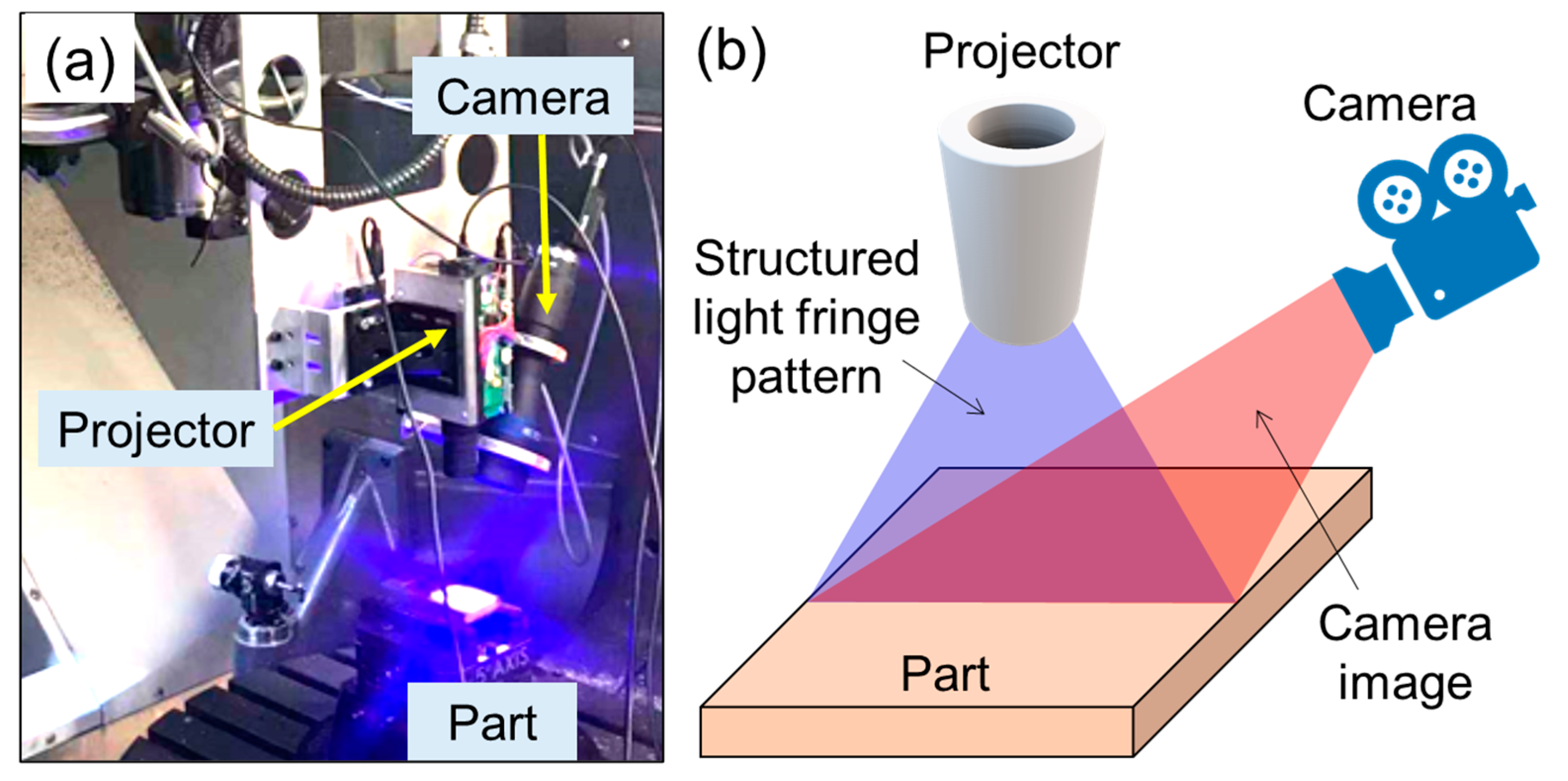
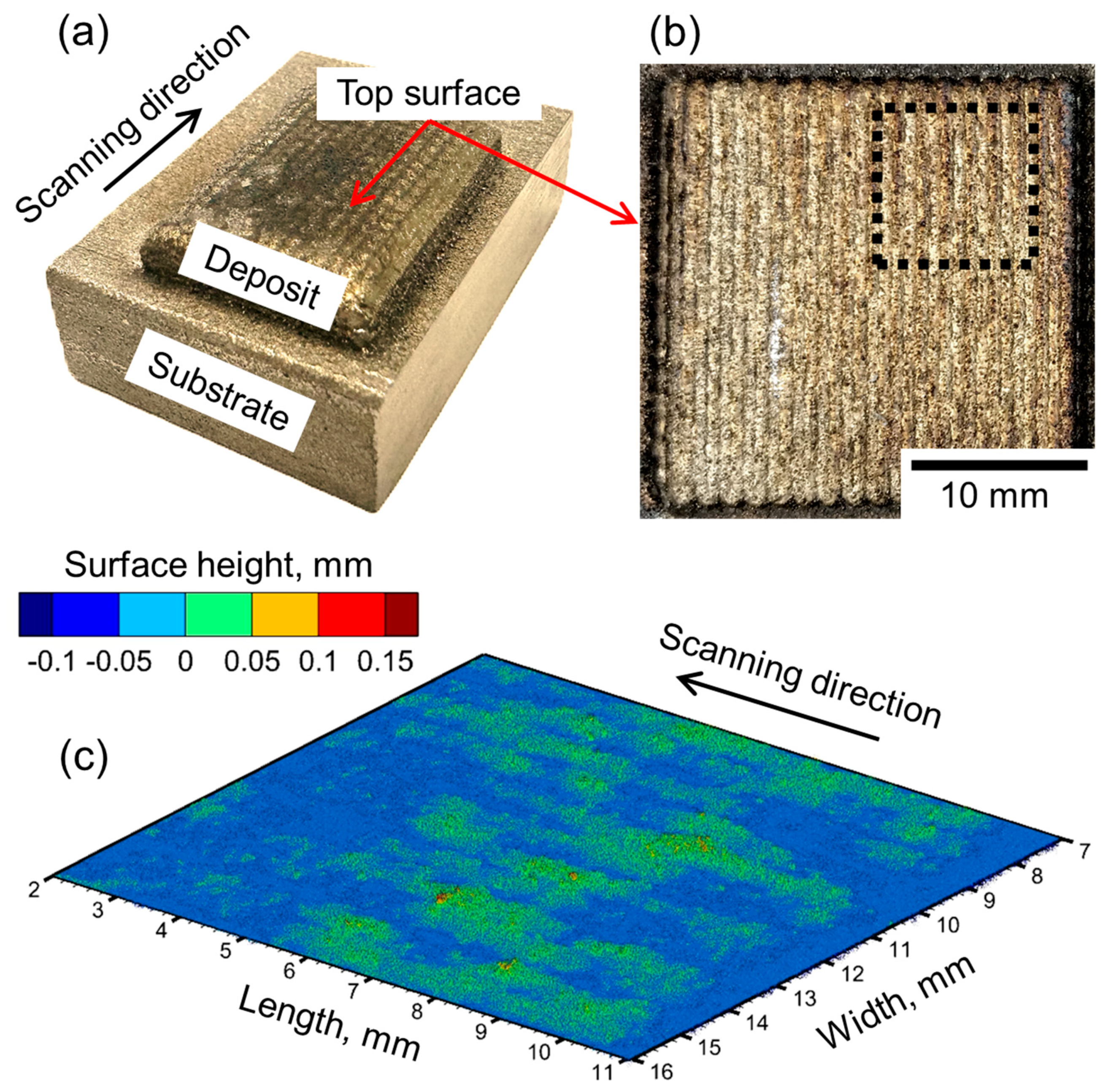

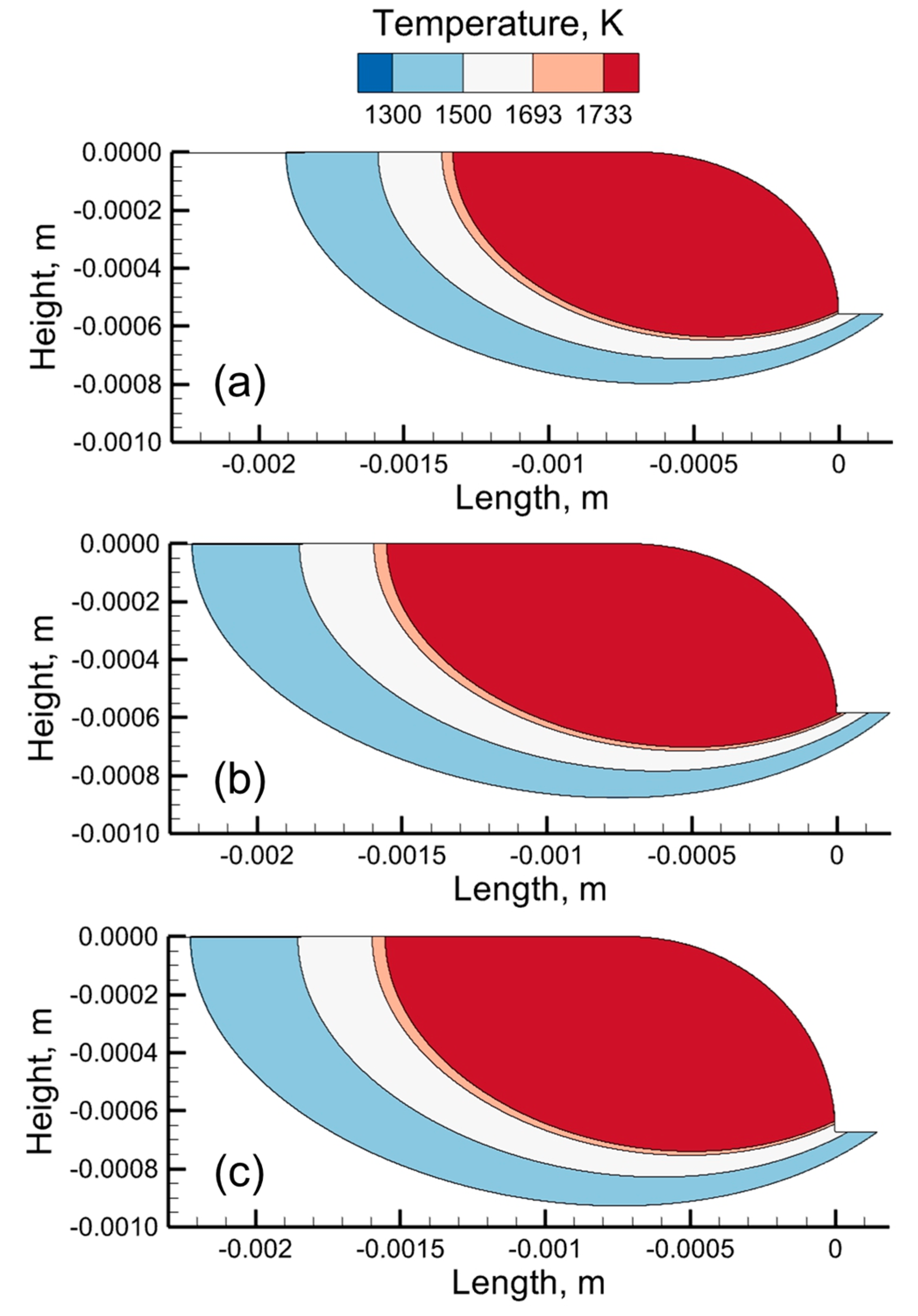
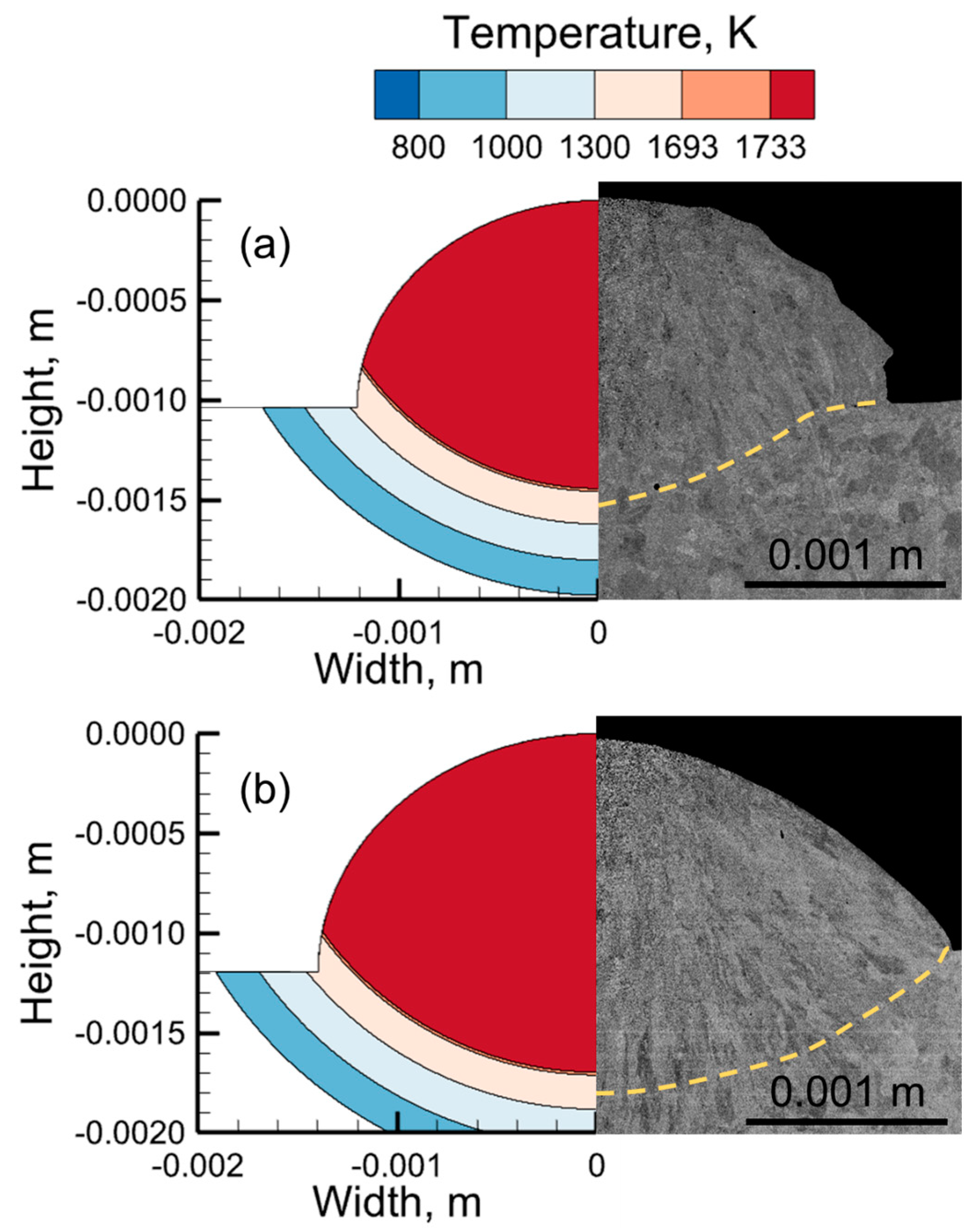
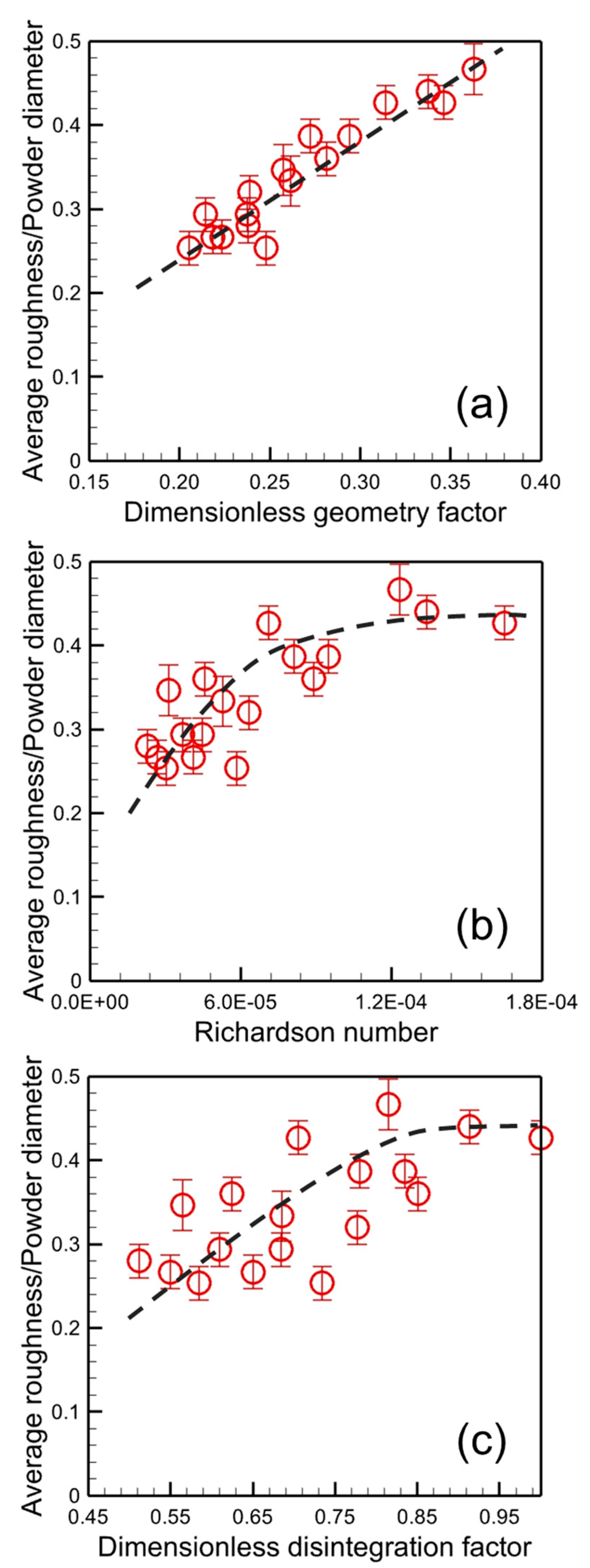
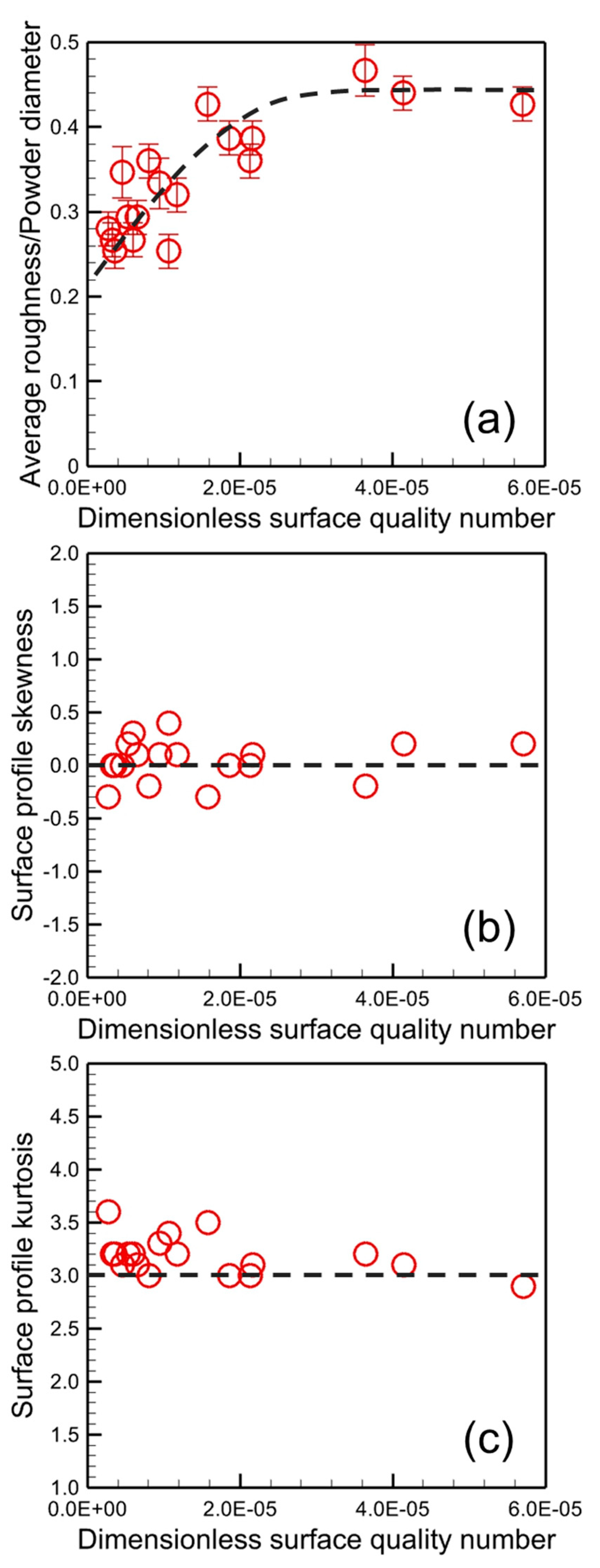
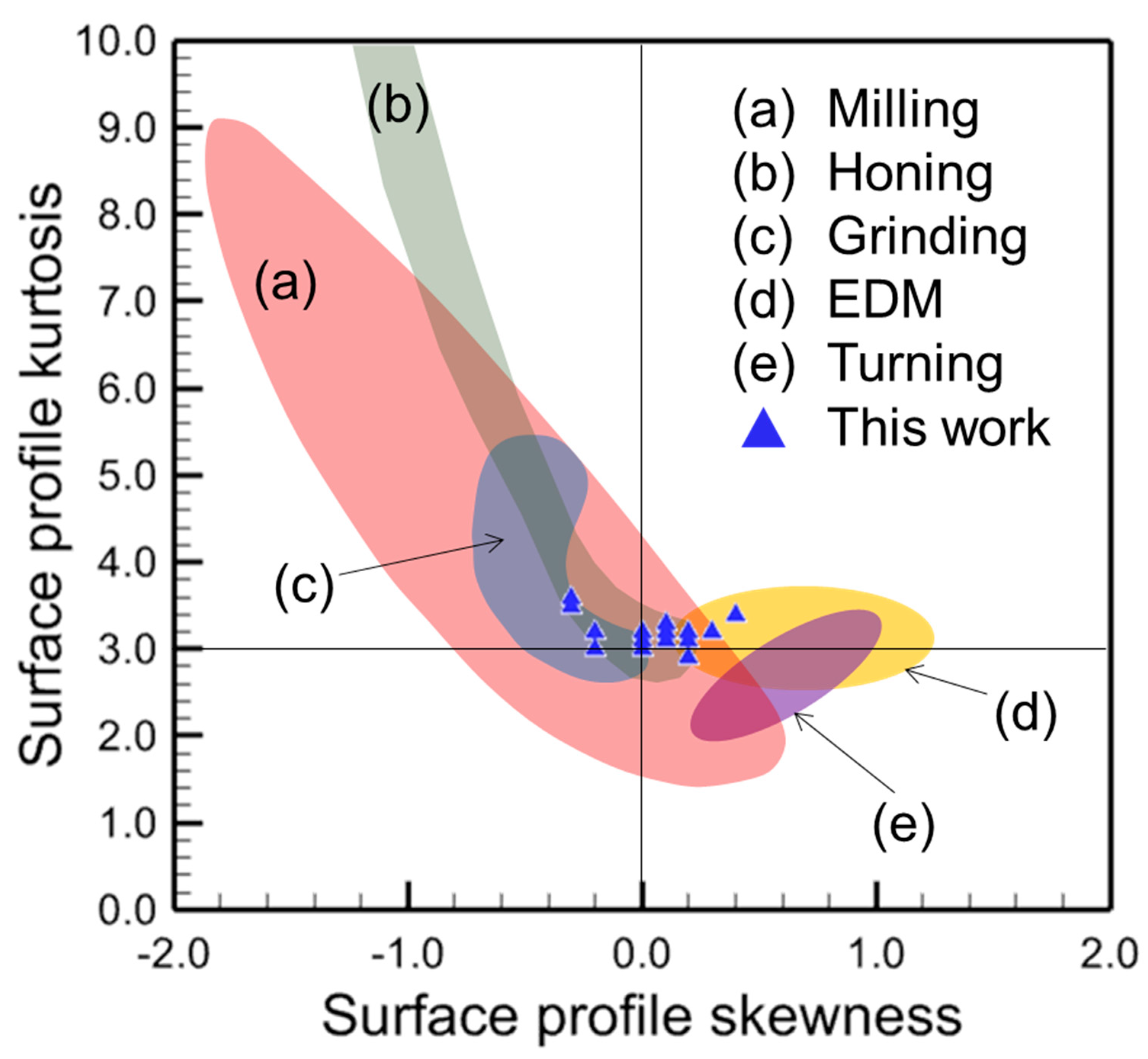

| Approach | Limitations | Reference | |
|---|---|---|---|
| Experimental | Post-process laser polishing with optimized processing conditions was used. | The process is expensive, difficult to apply for internal surfaces, and can promote other defects and undesirable microstructure. | [8] |
| Post-process laser remelting removed the traces of the spatter and unmelted powder to improve the surface quality. | The process is time-consuming, expensive, and applicable only to external surfaces. | [9,10] | |
| Post-process laser remelting reduced surface roughness and waviness. | The process is tested only for thin wall structures. In addition, there is no guided approach to select the power of remelting laser. | [11] | |
| Post-process laser polishing was applied at different laser energy levels to improve surface finish. | The process is time-consuming and applicable only to the external surfaces. | [12] | |
| An annular laser beam produced a higher temperature at the deposit edges than at the center and was beneficial to obtain smooth surfaces. | Commercial LDED machines have limited flexibility in adjusting the laser beam profile. | [13] | |
| The scanning direction was changed between two consecutive layers to minimize the surface unevenness. | Changing scanning direction between layers can result in other defects such as lack of fusion. | [14] | |
| Process parameters such as power of the laser beam and scanning speed were adjusted to improve surface quality. | Trial-and-error adjustment of process variables is time-consuming and expensive. | [15,16] | |
| Computational and data sciences | A three-phase computational fluid dynamics model was used to observe the melting dynamics of individual powder particles to understand the evolution of surface features. | Powder scale models simulating the dynamics of individual powder particles are computationally intensive and can not be used in real time. | [17] |
| A thermal finite element simulation was used to adjust the laser power to control the melt pool dimensions and surface quality. | A limited understanding of the relations between the temperature field and surface quality can make the part-scale thermal models inefficient. | [18] | |
| A simplified geometric model was used to obtain the track overlap to approaximately predict the surface smoothness. | This model did not consider the effects of temperature fields and molten pool geometry on surface quality. | [19] | |
| Multiphysics Object-Oriented Simulation Environment based model was used to obtain the deposit surface features. | This approach did not provide the local surface roughness, skewness, and kurtosis | [20] | |
| Statistical correlations and machine learning frameworks were established to reduce surface roughness by adjusting process variables. | The use of statistical correlations and machine learning depends on the availability of high-quality data. | [21,22,23] |
Disclaimer/Publisher’s Note: The statements, opinions and data contained in all publications are solely those of the individual author(s) and contributor(s) and not of MDPI and/or the editor(s). MDPI and/or the editor(s) disclaim responsibility for any injury to people or property resulting from any ideas, methods, instructions or products referred to in the content. |
© 2024 by the authors. Licensee MDPI, Basel, Switzerland. This article is an open access article distributed under the terms and conditions of the Creative Commons Attribution (CC BY) license (https://creativecommons.org/licenses/by/4.0/).
Share and Cite
Mukherjee, T.; Shen, W.; Liao, Y.; Li, B. Improving Deposited Surface Quality in Additive Manufacturing Using Structured Light Scanning Characterization and Mechanistic Modeling. J. Manuf. Mater. Process. 2024, 8, 124. https://doi.org/10.3390/jmmp8030124
Mukherjee T, Shen W, Liao Y, Li B. Improving Deposited Surface Quality in Additive Manufacturing Using Structured Light Scanning Characterization and Mechanistic Modeling. Journal of Manufacturing and Materials Processing. 2024; 8(3):124. https://doi.org/10.3390/jmmp8030124
Chicago/Turabian StyleMukherjee, Tuhin, Weijun Shen, Yiliang Liao, and Beiwen Li. 2024. "Improving Deposited Surface Quality in Additive Manufacturing Using Structured Light Scanning Characterization and Mechanistic Modeling" Journal of Manufacturing and Materials Processing 8, no. 3: 124. https://doi.org/10.3390/jmmp8030124






